How to Choose an UF technology for Your Facility?
Ultrafiltration is an analytical procedure in which a semi-permeable membrane is separated using a force such as pressure or a concentration gradient. Suspended solids with a high molecular weight cannot flow through the membrane in this approach, but water and low molecular solutes can. The retentate is the residue that cannot pass through the membrane, whereas the permeate or filtrate is the fraction that can pass through the filter. This approach is beneficial in the purifying and concentrating processes.
Factors to consider before selecting a better Ultra-filtration technique
1: What's in your drinking water?
What is in your water is the most evident and significant aspect that influences how you treat your water/wastewater. Because of their size, concentration, and influence on the chemistry of the fluids, different contaminants will require different limits.
2: Size of the particles
The pore sizing of the chosen membrane will be determined by the diameters of the smaller contaminating particles. Ultrafiltration membranes are available in thicknesses ranging from 0.1 to 0.01 microns. As a general rule, use a membrane with pores that are one tenth the size of the smallest particles to be filtered. Larger particles are retained on the surface and do not lodge within the pores, allowing smaller particles to pass through. With a cross flow, maintaining the solid surface layer is easier, and back washing is more effective.
3: Concentrations
A few design factors about the layout of the UF water treatment system will be determined by the concentration of solid components in the raw water. Whether the flow is cross or dead-end, and whether it is inside-out or outside-in. For dead-end, inside-out flow, lower solids concentrations are optimal. Inside-out flow offers more uniform flow characteristics and uses less energy to produce than cross flow.It all comes down to how quickly the membrane's surface layer accumulates particles. Since every bit of organic solid remains on the membrane in dead-end arrangements, a layer will quickly form.
Inside-out flow, particularly in hollow fibre and tubular membranes, has the potential to totally block the permeate tubes over time.
Cross-flow, on the other hand, carries surplus materials parallel to the membrane rather than depositing them directly on its surface. In cases where there is a lot of solid loading, this allows for extended run periods. There is no inner circumference to obstruct in outside-in flows.
4: Temperature, pH, and chemicals
Membrane materials differ in their ability to withstand severe effluent conditions. Polymeric membranes are less expensive in general, but they are more prone to breakdown in the presence of strongly alkaline or acidic pH's, as well as greater temperatures. Ceramic membranes, on the other hand, can withstand a wider range of circumstances but are significantly more expensive. Polymeric membranes come in a variety of shapes and sizes, and some can be utilised in more volatile environments, while a ceramic membrane may last far longer before needing to be replaced.
How much room do you have available?
Although UF water treatment systems are generally smaller than other filtration technologies, there is some variation in membrane configurations.
Submerged systems, for example, are larger than pressurised vessels, while spiral wound membranes are smaller than plate and frame membranes. Integrated aeration systems don't require a separate tank, and hollow fibre membranes have a larger surface area than tubular membranes in the same volume vessel. Compact systems are easier to integrate into existing treatment systems, but depending on the water quality, they may require more regular back washing.
How frequently do you want to change the membranes?
It's unavoidable that filters will need to be replaced at some point. However, frequent replacement can be pricey, so it's critical to keep the system in good working order to keep costs down. There are a few options to examine singly or in combination to do this. Even in volatile effluent circumstances, more resilient membrane materials such as specialised neutral charged polymeric or ceramic will endure a long period.
Membrane fouling can be reduced with the right pre-treatment programme. Pore sizing is important because it prevents particles from settling within the pores, making back washes more efficient.
Hopefully, the user will go through these parameters before making any decision, but a water treatment professional who can walk you through potential solutions based on your individual water analysis and any relevant design criteria can teach you a lot more.
Netsol Water is Greater Noida-based leading water & wastewater treatment plant manufacturer. We are industry's most demanding company based on client review and work quality. We are known as best commercial RO plant manufacturers, industrial RO plant manufacturer, sewage treatment plant manufacturer, Water Softener Plant Manufacturers and effluent treatment plant manufacturers. Apart from this 24x7 customer support is our USP. Call on +91-9650608473, or write us at enquiry@netsolwater.com for any support, inquiry or product-purchase related query.



